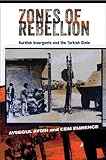Zones of Rebellion : Kurdish Insurgents and the Turkish State / Aysegul Aydin and Cem Emrence.
Material type: TextPublication details: Ithaca : Cornell University Press, (c)2015.Description: 1 online resourceContent type:
TextPublication details: Ithaca : Cornell University Press, (c)2015.Description: 1 online resourceContent type: - text
- computer
- online resource
- 9780801456206
- DR435 .Z664 2015
- COPYRIGHT NOT covered - Click this link to request copyright permission: https://lib.ciu.edu/copyright-request-form
| Item type | Current library | Collection | Call number | URL | Status | Date due | Barcode | |
|---|---|---|---|---|---|---|---|---|
 Online Book (LOGIN USING YOUR MY CIU LOGIN AND PASSWORD)
Online Book (LOGIN USING YOUR MY CIU LOGIN AND PASSWORD)
|
G. Allen Fleece Library ONLINE | Non-fiction | DR435.87 (Browse shelf(Opens below)) | Link to resource | Available | ocn908447876 |
Browsing G. Allen Fleece Library shelves, Shelving location: ONLINE, Collection: Non-fiction Close shelf browser (Hides shelf browser)
Includes bibliographies and index.
Zone making -- Midfield wars -- Origins of violence -- Looking ahead -- Insurgency -- Organization -- Competitive origins -- Building trust -- Extracting resources -- The Weberian experiment failed -- Organizational inertia -- Ideology -- Fight for independence -- Inviting foreign pressure -- Domestic bargaining -- Strategy -- A border specialist -- Reaching out -- High premiums -- Back to Botan -- Counterinsurgency -- Organization -- Administrative solutions -- Specialist governance -- Redistricting -- Rural retreat -- Ideology -- Rural bias -- Foreign sponsors -- Developmentalist response -- The backup plan: co-optation model -- Strategy -- Locating the insurgent -- Sweep and strike -- Curbing civilian unrest -- No-entry zone -- Forging identities -- Path dependent origins -- Room for contingency.
How do insurgents and governments select their targets? Which ideological discourses and organizational policies do they adopt to win civilian loyalties and control territory? This book suggests that both insurgents and governments adopt a wide variety of coercive strategies in war environments. The book integrates Turkish-Ottoman history with social science theory and unveils long-term policies that continue to inform the distribution of violence in Anatolia. It shows the astonishing similarity in combatants' practices over time and their resulting inability to consolidate Kurdish people and territory around their respective political agendas.
COPYRIGHT NOT covered - Click this link to request copyright permission:
There are no comments on this title.






